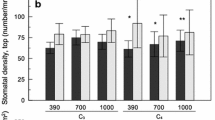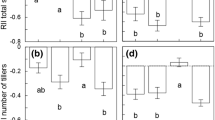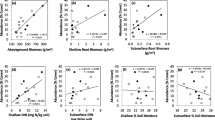Abstract
The ongoing increase in atmospheric CO2 concentration ([CO2]) is likely to change the species composition of plant communities. To investigate whether growth of a highly invasive plant species, Centaurea solstitialis (yellow starthistle), was affected by elevated [CO2], and whether the success of this species would increase under CO2 enrichment, I grew the species in serpentine soil microcosms, both as a monoculture and as a component of a grassland community. Centaurea grown in monoculture responded strongly to [CO2] enrichment of 350 μmol mol−1, increasing aboveground biomass production by 70%, inflorescence production by 74%, and midday photosynthesis by an average of 132%. When grown in competition with common serpentine grassland species, Centaurea responded to CO2 enrichment with similar but nonsignificant increases (+69% aboveground biomass, +71% inflorescence production), while total aboveground biomass of the polyculture increased by 28%. Centaurea's positive CO2 response in monoculture and parallel (but non-significant) response in polyculture provoke questions about possible consequences of increasing CO2 for more typical California grasslands, where the invader already causes major problems.
Similar content being viewed by others
References
Arp, W.J., Drake, B.G., Pockman, W.T., Curtis, P.S. & Whigham, D. F. 1993. Interactions between C3 and C4 salt-marsh plant species during 4 years of exposure to elevated atmospheric CO2. Vegetatio 104: 133-143.
Chapin, F. S., III, Shaver, G. R., Giblin, A. E., Nadelhoffer, K. J. & Laundre, J. A. 1995. Responses of arctic tundra to experimental and observed changes in climate. Ecology 76: 694-711.
Chiariello, N. R. & Field, C. B. 1996. Annual grassland responses to elevated CO2 in long-term community microcosms. pp. 139-157. In: C. Körner & F. A. Bazzaz (eds), Carbon dioxide, populations, and communities. Academic Press, San Diego.
Cordy, D.R. 1954. Nigropallidal encephalomalacia in horses associated with ingestion of yellow starthistle. J. Neuropathol. Exp. Neurol. 13: 330-342.
Dukes, J. S. 2000. Will the increasing atmospheric CO2 concentration affect the success of invasive species? pp. 95-113. In: H. A. Mooney & R. J. Hobbs (eds), Invasive species in a changing world. Island Press, Washington.
Dukes, J. S. 2001. Biodiversity and invasibility in grassland microcosms. Oecologia 126: 563-568.
Dukes, J. S. & Mooney, H. A. 1999. Does global change increase the success of biological invaders? Trends Ecol. Evol. 14: 135-139.
Field, C. B., Chapin, F. S., III, Chiariello, N. R., Holland, E. A. & Mooney, H. A. 1996. The Jasper Ridge CO2 experiment: Design and motivation. pp. 121-145. In: G. W. Koch & H.A. Mooney (eds), Ecosystem responses to elevated CO2. Academic Press, London.
Field, C. B., Lund, C. P., Chiariello, N. R. & Mortimer, B. E. 1997. CO2 effects on the water budget of grassland microcosm communities. Global Change Biol. 3: 197-206.
Fredeen, A. L., Randerson, J. T., Holbrook, N. M. & Field, C. B. 1997. Elevated atmospheric CO2 increases water availability in a water-limited grassland ecosystem. J. Am. Water Res. Assoc. 33: 1033-1039.
Frenkel, R. E. 1970. Ruderal vegetation along some California roadsides. University of California Press, Berkeley, California.
Harte, J. & Shaw, R. 1995. Shifting dominance within a montane vegetation community: Results of a climate-warming experiment. Science 267: 876-880.
Hickman, J. C. (ed.). 1993. The Jepson manual: higher plants of California. University of California Press, Berkeley.
Hobbs, R. J., Gulmon, S. L., Hobbs, V. J. & Mooney, H. A. 1988. Effects of fertilizer addition and subsequent gopher disturbance on a serpentine annual grassland community. Oecologia 75: 291-295.
Hobbs, R. J. & Mooney, H. A. 1991. Effects of rainfall variability and gopher disturbance on serpentine annual grassland dynamics. Ecology 72: 59-68.
Hobbs, R. J. & Mooney, H. A. 1995. Spatial and temporal variability in California annual grassland: results from a long-term study. J. Veg. Sci. 6: 43-56.
Huenneke, L. F., Hamburg, S. P., Koide, R., Mooney, H. A. & Vitousek, P. M. 1990. Effects of soil resources on plant invasion and community structure in Californian [USA] serpentine grassland. Ecology 71: 478-491.
Hungate, B. A., Chapin, F. S., III, Zhong, H., Holland, E. A. & Field, C. B. 1997. Stimulation of grassland nitrogen cycling under carbon-dioxide enrichment. Oecologia 109: 149-153.
Huxman, T. E., Hamerlynck, E. P., Jordan, D. N., Salsman, K. J. & Smith, S. D. 1998. The effects of parental CO2 environment on seed quality and subsequent seedling performance in Bromus rubens. Oecologia 114: 202-208.
Jackson, R. B., Sala, O. E., Field, C. B. & Mooney, H. A. 1994. CO2 alters water use, carbon gain, and yield for the dominant species in a natural grassland. Oecologia 98: 257-262.
Kruckeberg, A. R. 1984. California serpentines: flora, vegetation, geology, soils, and management problems. University of California Press, Berkeley, California.
Leadley, P. W., Niklaus, P. A., Stocker, R. & Körner, C. 1999. A field study of the effects of elevated CO2 on plant biomass and community structure in a calcareous grassland. Oecologia 118: 39-49.
Maddox, D. M. 1981. Introduction, phenology, and density of yellow starthistle in coastal, intercoastal, and Central Valley situations in California. U.S. Department of Agriculture, Agricultural Research Service, Report ARR-W-20.
Maddox, D. M. & Mayfield, A. 1985. Yellow starthistle infestations are on the increase. California Agric. 39: 10-12.
Maddox, D. M., Mayfield, A. & Poritz, N.H. 1985. Distribution of yellow starthistle (Centaurea solstitialis) and Russian knapweed (Centaurea repens). Weed Sci. 33: 315-327.
Murphy, D. D. & Ehrlich, P. R. 1989. Conservation biology of California's remnant native grasslands. pp. 201-211. In: L. F. Huenneke & H. A. Mooney (eds), Grassland structure and function: California annual grassland. Kluwer Academic Publishers, Dordrecht, The Netherlands.
Owensby, C. E., Ham, J. M., Knapp, A. K. & Auen, L. M. 1999. Biomass production and species composition change in a tallgrass prairie ecosystem after long-term exposure to elevated atmospheric CO2. Global Change Biol. 5: 497-506.
Pitcairn, M. J., O'Connell, R. A. & Gendron, J. M. 1998. Yellow starthistle: survey of statewide distribution. pp. 64-66. In: D. M. Woods (ed.), Biological control program annual summary, 1997. California Department of Food and Agriculture, Plant Health and Pest Prevention Services, Sacramento, California.
Roché, B. F., Jr. 1992. Achene dispersal in yellow starthistle (Centaurea solstitialis L.). Northwest Sci. 66: 62-65.
Sasek, T. W. & Strain, B. R. 1988. Effects of carbon dioxide enrichment on the growth and morphology of kudzu (Pueraria lobata). Weed Sci. 36: 28-36.
Smith, S. D., Huxman, T. E., Zitzer, S. F., Charlet, T. N., Housman, D. C., Coleman, J. S., Fenstermaker, L. K., Seemann, J. R. & Nowak, R. S. 2000. Elevated CO2 increases productivity and invasive species success in an arid ecosystem. Nature 408: 79-82.
Smith, S. D., Strain, B. R. & Sharkey, T. D. 1987. Effects of carbon dioxide enrichment on four Great Basin [USA] grasses. Funct. Ecol. 1: 139-144.
Weiss, S. B. 2000. Cars, cows, and checkerspot butterflies: nitrogen deposition and management of nutrient poor grasslands for a threatened species. Cons. Biol. 13: 1476-1486.
Author information
Authors and Affiliations
Rights and permissions
About this article
Cite this article
Dukes, J.S. Comparison of the effect of elevated CO2 on an invasive species (Centaurea solstitialis) in monoculture and community settings. Plant Ecology 160, 225–234 (2002). https://doi.org/10.1023/A:1015813919850
Issue Date:
DOI: https://doi.org/10.1023/A:1015813919850




